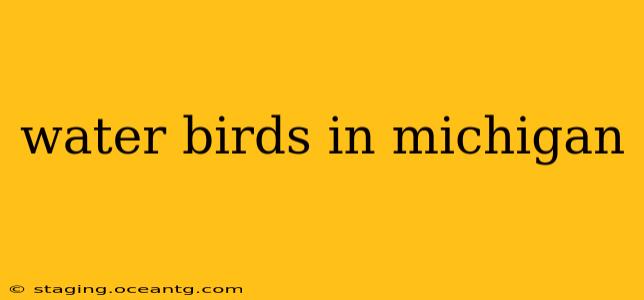Michigan, with its vast Great Lakes shoreline, numerous inland lakes, rivers, and wetlands, boasts a rich diversity of water bird species. From the majestic loon to the playful duck, these avian inhabitants add vibrancy and beauty to the state's natural landscape. This guide explores the fascinating world of Michigan's water birds, covering identification, habitat, and conservation efforts.
What are the most common water birds in Michigan?
Some of the most commonly sighted water birds in Michigan include various species of ducks (Mallards, Wood Ducks, Canada Geese), loons (Common Loon, Red-throated Loon), grebes (Pied-billed Grebe, Horned Grebe), herons (Great Blue Heron, Great Egret), and gulls (Ring-billed Gull, Herring Gull). The specific species you'll encounter will depend heavily on the time of year and the location within the state. Coastal areas will offer different species than inland lakes and rivers.
What kind of ducks are found in Michigan?
Michigan is home to a remarkable variety of ducks, both resident and migratory. Some of the most frequently seen include:
- Mallards: Easily recognizable by the green head of the male and the mottled brown feathers of the female. They are found in a wide range of habitats.
- Wood Ducks: Known for their vibrant iridescent plumage, these ducks prefer wooded areas near water.
- Canada Geese: While technically geese, they are often included in discussions of water birds due to their aquatic habits. They are large and easily identifiable.
- Ring-necked Ducks: These ducks have a distinctive white ring around their neck. They are often found in shallow lakes and marshes.
- Northern Pintails: Elegant ducks with long, slender tails, found in various wetland habitats.
Where can I see water birds in Michigan?
Michigan offers numerous excellent locations for birdwatching. Some popular spots include:
- The Great Lakes shorelines: Excellent for observing migrating waterfowl and gulls.
- Sleeping Bear Dunes National Lakeshore: A diverse landscape with beaches, forests, and inland lakes offering a wide variety of bird species.
- Seney National Wildlife Refuge: A crucial habitat for migratory birds, particularly waterfowl.
- Point Pelee National Park (Ontario, Canada – close proximity): While technically in Canada, it's a short trip for avid birders and a fantastic location for observing migrating birds, including many water species. Many of the birds seen here also pass through Michigan.
- Various state parks and wildlife areas: Check your local DNR website for a list of parks near you with known water bird populations.
What is the best time of year to see water birds in Michigan?
Migration seasons (spring and fall) are generally the best times to see the greatest diversity of water birds in Michigan. However, many species are present year-round, especially resident ducks and geese. Spring offers the excitement of seeing birds returning from their wintering grounds, while fall provides opportunities to observe birds preparing for their southward journey.
What are some threats to water birds in Michigan?
Like many bird species worldwide, Michigan's water birds face various threats, including:
- Habitat loss: Development and degradation of wetlands and other crucial habitats significantly impact water bird populations.
- Pollution: Water pollution from agricultural runoff, industrial discharge, and other sources can contaminate food sources and negatively affect bird health.
- Climate change: Shifting weather patterns and rising water temperatures can disrupt breeding cycles and food availability.
- Predation: While natural predation is a part of the ecosystem, human-induced changes can alter predator-prey dynamics and negatively impact certain species.
How can I help protect Michigan's water birds?
Protecting Michigan's water birds requires a multifaceted approach:
- Support conservation organizations: Donate to or volunteer with organizations working to protect wetlands and other bird habitats.
- Practice responsible recreation: Avoid disturbing birds during nesting season, keep dogs on leashes near water bodies, and dispose of trash properly.
- Advocate for responsible land use policies: Support policies that protect wetlands and prevent habitat loss.
- Reduce your carbon footprint: Contribute to mitigating the effects of climate change.
By understanding the diversity of Michigan's water birds, their habitats, and the challenges they face, we can become better stewards of these magnificent creatures and the ecosystems they call home. Remember to always practice responsible birdwatching and contribute to conservation efforts to ensure future generations can enjoy the beauty and wonder of Michigan's avian wildlife.
